BMW 335I XDRIVE 2009 Owners Manual
Manufacturer: BMW, Model Year: 2009, Model line: 335I XDRIVE, Model: BMW 335I XDRIVE 2009Pages: 268, PDF Size: 11.52 MB
Page 191 of 268
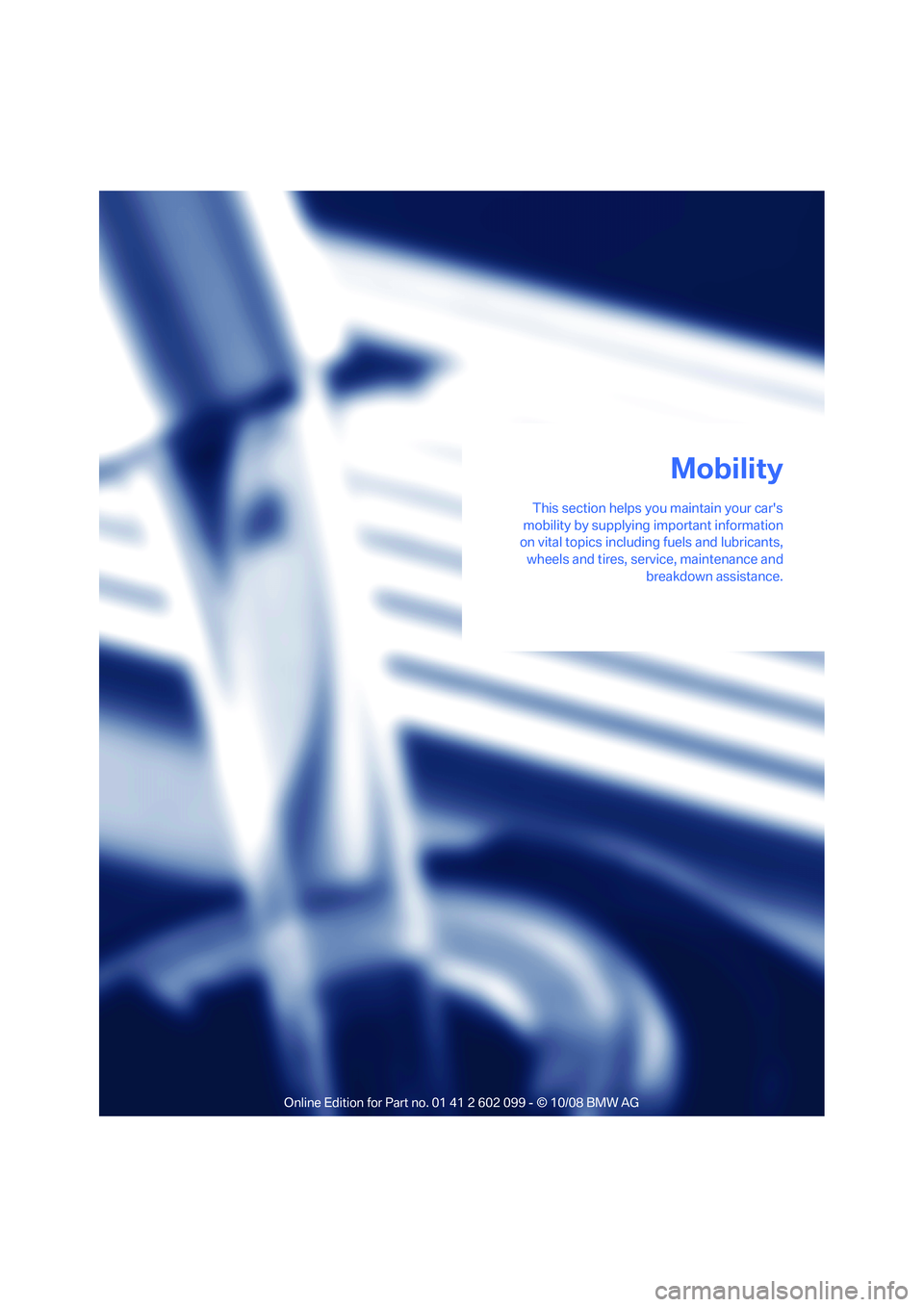
Mobility
This section helps you maintain your car's
mobility by supplying important information
on vital topics including fuels and lubricants,
wheels and tires, serv ice, maintenance and
breakdown assistance.
Mobility
ba8_E9091_cic.book Seite 189 Mittwoch, 29. Oktober 2008 2:59 14
Page 192 of 268
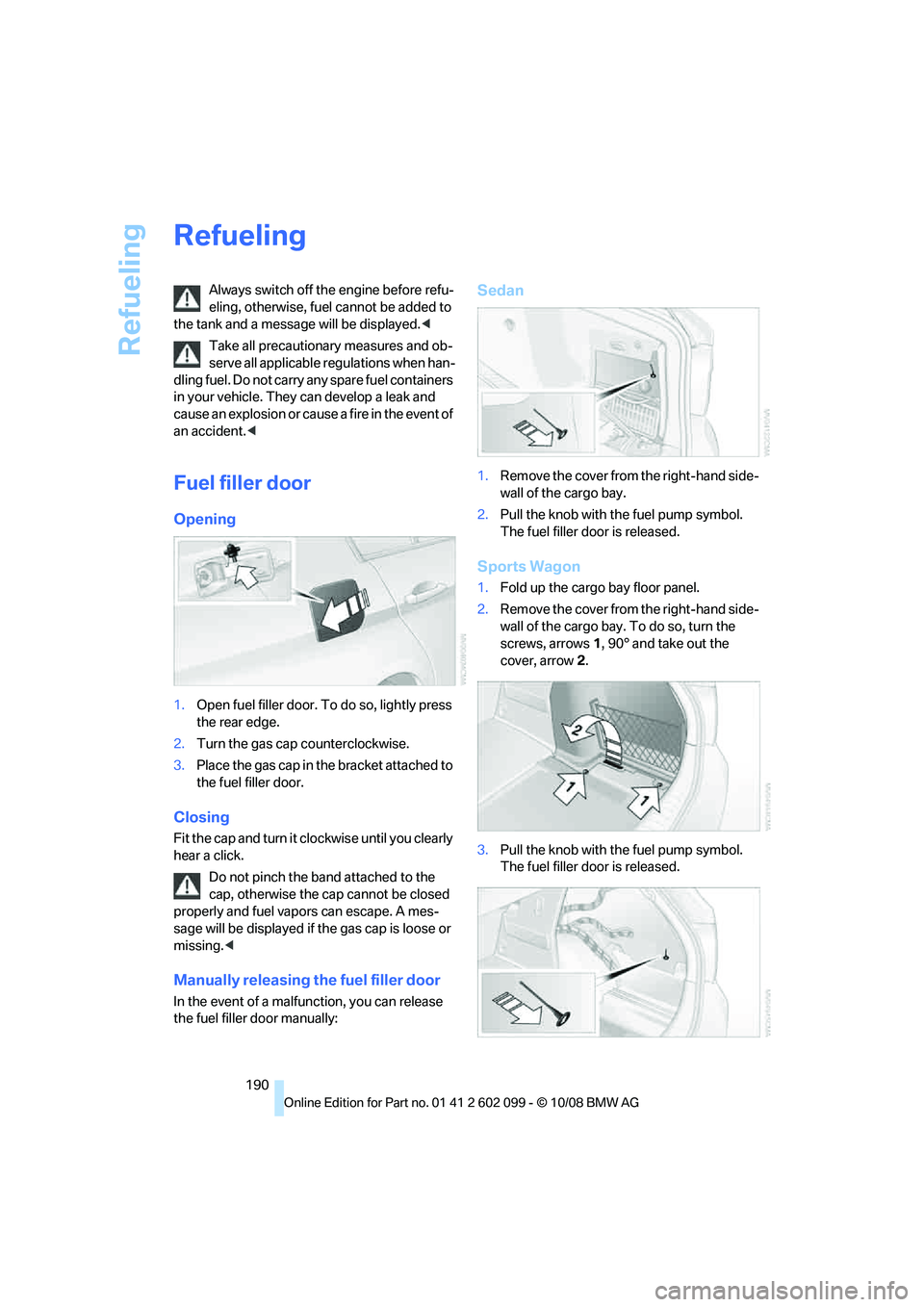
Refueling
190
Refueling
Always switch off the engine before refu-
eling, otherwise, fuel cannot be added to
the tank and a messag e will be displayed.<
Take all precautionary measures and ob-
serve all applicable regulations when han-
dling fuel. Do not carry any spare fuel containers
in your vehicle. They can develop a leak and
cause an explosion or cause a fire in the event of
an accident. <
Fuel filler door
Opening
1.Open fuel filler door. To do so, lightly press
the rear edge.
2. Turn the gas cap counterclockwise.
3. Place the gas cap in th e bracket attached to
the fuel filler door.
Closing
Fit the cap and turn it cl ockwise until you clearly
hear a click.
Do not pinch the band attached to the
cap, otherwise the cap cannot be closed
properly and fuel vapors can escape. A mes-
sage will be displayed if the gas cap is loose or
missing. <
Manually releasing the fuel filler door
In the event of a malfunction, you can release
the fuel filler door manually:
Sedan
1.Remove the cover from the right-hand side-
wall of the cargo bay.
2. Pull the knob with the fuel pump symbol.
The fuel filler door is released.
Sports Wagon
1.Fold up the cargo bay floor panel.
2. Remove the cover from the right-hand side-
wall of the cargo bay. To do so, turn the
screws, arrows 1, 90° and take out the
cover, arrow 2.
3. Pull the knob with the fuel pump symbol.
The fuel filler door is released.
ba8_E9091_cic.book Seite 190 Mittwoch, 29. Oktober 2008 2:59 14
Page 193 of 268
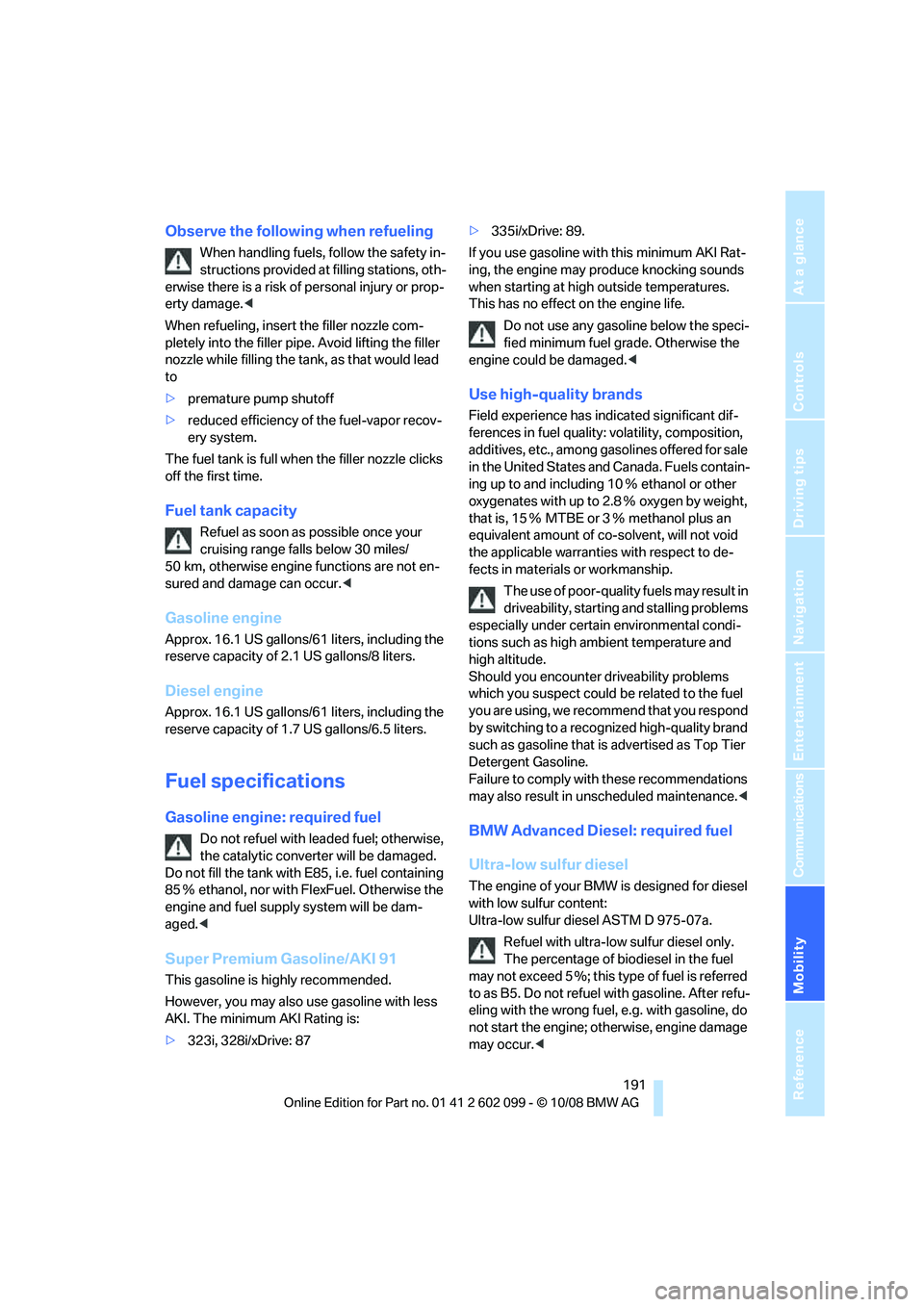
Mobility
191Reference
At a glance
Controls
Driving tips
Communications
Navigation
Entertainment
Observe the following when refueling
When handling fuels, follow the safety in-
structions provided at filling stations, oth-
erwise there is a risk of personal injury or prop-
erty damage. <
When refueling, insert the filler nozzle com-
pletely into the filler pipe . Avoid lifting the filler
nozzle while filling the ta nk, as that would lead
to
> premature pump shutoff
> reduced efficiency of the fuel-vapor recov-
ery system.
The fuel tank is full when the filler nozzle clicks
off the first time.
Fuel tank capacity
Refuel as soon as possible once your
cruising range falls below 30 miles/
50 km, otherwise engine functions are not en-
sured and damage can occur. <
Gasoline engine
Approx. 16.1 US gallons/61 liters, including the
reserve capacity of 2.1 US gallons/8 liters.
Diesel engine
Approx. 16.1 US gallons/61 liters, including the
reserve capacity of 1.7 US gallons/6.5 liters.
Fuel specifications
Gasoline engine: required fuel
Do not refuel with leaded fuel; otherwise,
the catalytic conver ter will be damaged.
Do not fill the tank with E85, i.e. fuel containing
85 Ξ ethanol, nor with Fl exFuel. Otherwise the
engine and fuel suppl y system will be dam-
aged. <
Super Premium Gasoline/AKI 91
This gasoline is hi ghly recommended.
However, you may also use gasoline with less
AKI. The minimum AKI Rating is:
> 323i, 328i/xDrive: 87 >
335i/xDrive: 89.
If you use gasoline with this minimum AKI Rat-
ing, the engine may produce knocking sounds
when starting at high outside temperatures.
This has no effect on the engine life.
Do not use any gasoline below the speci-
fied minimum fuel grade. Otherwise the
engine could be damaged. <
Use high-quality brands
Field experience has indicated significant dif-
ferences in fuel quality: volatility, composition,
additives, etc., among gasolines offered for sale
in the United States and Canada. Fuels contain-
ing up to and including 10Ξ ethanol or other
oxygenates with up to 2.8 Ξ oxygen by weight,
that is, 15 Ξ MTBE or 3 Ξ methanol plus an
equivalent amount of co-solvent, will not void
the applicable warrantie s with respect to de-
fects in materials or workmanship.
The use of poor-quality fuels may result in
driveability, starting and stalling problems
especially under certain environmental condi-
tions such as high ambient temperature and
high altitude.
Should you encounter driveability problems
which you suspect could be related to the fuel
y o u a r e u s i n g , w e r e c o m m e n d t h a t y o u r e s p o n d
by switching to a recogn ized high-quality brand
such as gasoline that is advertised as Top Tier
Detergent Gasoline.
Failure to comply with these recommendations
may also result in un scheduled maintenance. <
BMW Advanced Diesel: required fuel
Ultra-low sulfur diesel
The engine of your BMW is designed for diesel
with low sulfur content:
Ultra-low sulfur diesel ASTM D 975-07a.
Refuel with ultra-low sulfur diesel only.
The percentage of biodiesel in the fuel
may not exceed 5 %; this type of fuel is referred
to as B5. Do not refuel with gasoline. After refu-
eling with the wrong fuel, e.g. with gasoline, do
not start the engine; otherwise, engine damage
may occur. <
ba8_E9091_cic.book Seite 191 Mittwoch, 29. Oktober 2008 2:59 14
Page 194 of 268
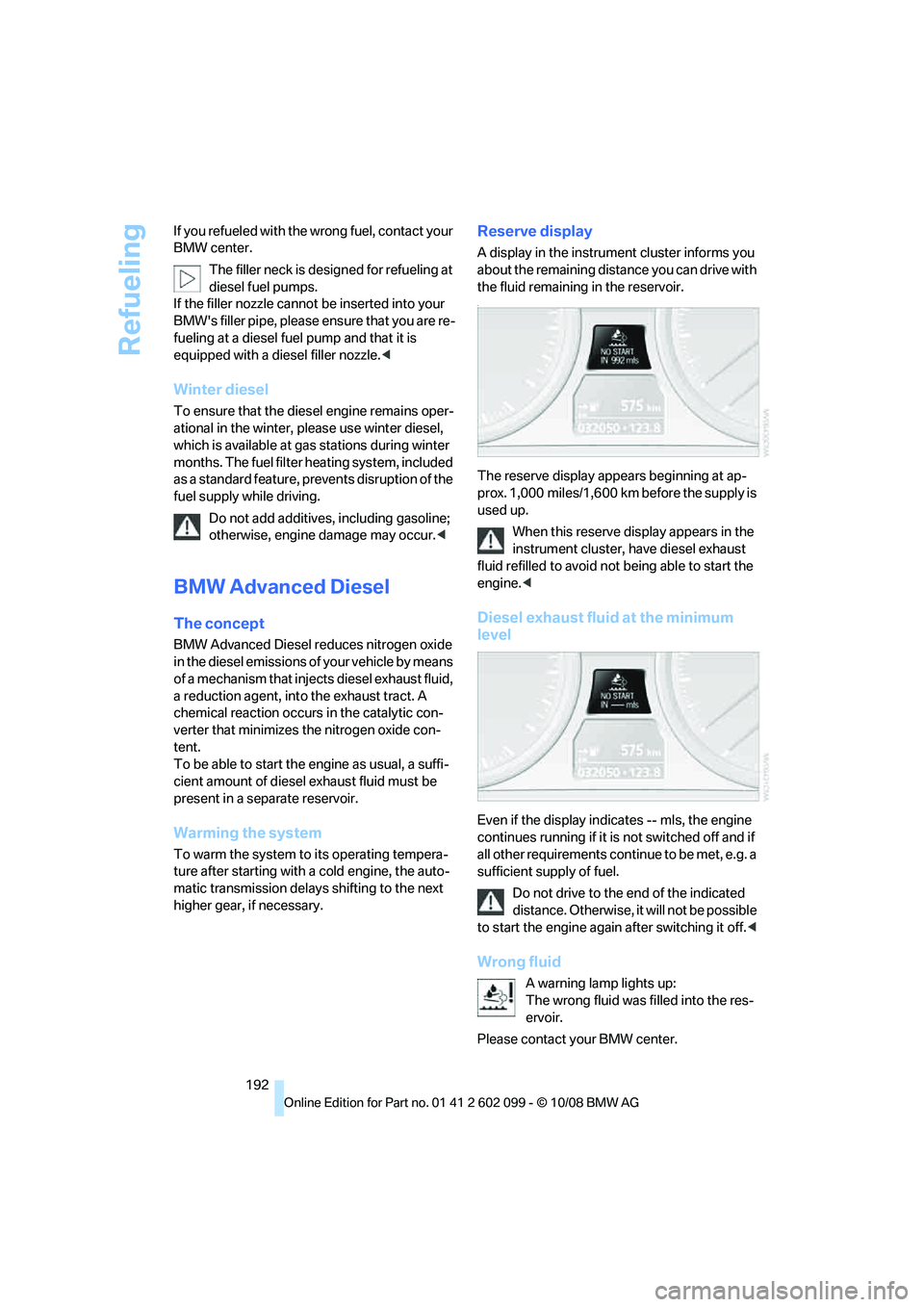
Refueling
192
If you refueled with the wrong fuel, contact your
BMW center.
The filler neck is desi gned for refueling at
diesel fuel pumps.
If the filler nozzle cannot be inserted into your
BMW's filler pipe, please ensure that you are re-
fueling at a diesel fuel pump and that it is
equipped with a diesel filler nozzle. <
Winter diesel
To ensure that the diesel engine remains oper-
ational in the winter, please use winter diesel,
which is available at gas stations during winter
months. The fuel filter heating system, included
as a standard feature, prevents disruption of the
fuel supply while driving.
Do not add additives, including gasoline;
otherwise, engine damage may occur. <
BMW Advanced Diesel
The concept
BMW Advanced Diesel reduces nitrogen oxide
in the diesel emissions of your vehicle by means
of a mechanism that injects diesel exhaust fluid,
a reduction agent, into the exhaust tract. A
chemical reaction occurs in the catalytic con-
verter that minimizes the nitrogen oxide con-
tent.
To be able to start the engine as usual, a suffi-
cient amount of diesel exhaust fluid must be
present in a separate reservoir.
Warming the system
To warm the system to its operating tempera-
ture after starting with a cold engine, the auto-
matic transmission delays shifting to the next
higher gear, if necessary.
Reserve display
A display in the instrument cluster informs you
about the remaining distance you can drive with
the fluid remaining in the reservoir.
-
The reserve display appears beginning at ap-
prox. 1,000 miles/1,600 km before the supply is
used up.
When this reserve display appears in the
instrument cluster, have diesel exhaust
fluid refilled to avoid not being able to start the
engine. <
Diesel exhaust fluid at the minimum
level
Even if the display indicates -- mls, the engine
continues running if it is not switched off and if
all other requirements cont inue to be met, e.g. a
sufficient supply of fuel.
Do not drive to the end of the indicated
distance. Otherwise, it will not be possible
to start the engine again after switching it off. <
Wrong fluid
A warning lamp lights up:
The wrong fluid was filled into the res-
ervoir.
Please contact your BMW center.
ba8_E9091_cic.book Seite 192 Mittwoch, 29. Oktober 2008 2:59 14
Page 195 of 268
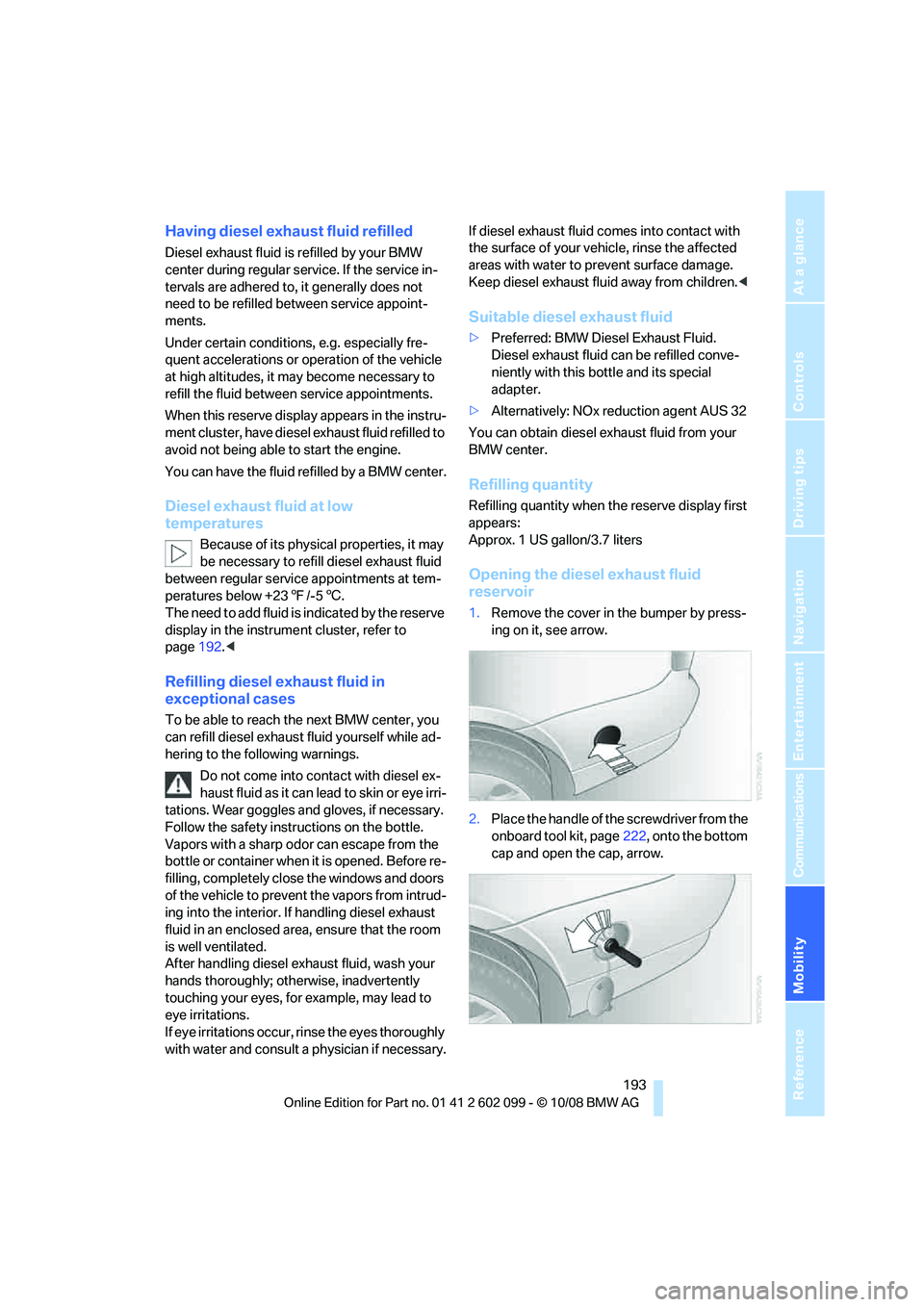
Mobility
193Reference
At a glance
Controls
Driving tips
Communications
Navigation
Entertainment
Having diesel exhaust fluid refilled
Diesel exhaust fluid is refilled by your BMW
center during regular service. If the service in-
tervals are adhered to, it generally does not
need to be refilled between service appoint-
ments.
Under certain conditions , e.g. especially fre-
quent accelerations or operation of the vehicle
at high altitudes, it may become necessary to
refill the fluid between service appointments.
When this reserve display appears in the instru-
ment cluster, have diesel exhaust fluid refilled to
avoid not being able to start the engine.
You can have the fluid refilled by a BMW center.
Diesel exhaust fluid at low
temperatures
Because of its physical properties, it may
be necessary to refill diesel exhaust fluid
between regular service appointments at tem-
peratures below +23 7/-5 6.
The need to add fluid is indicated by the reserve
display in the instrume nt cluster, refer to
page 192.<
Refilling diesel exhaust fluid in
exceptional cases
To be able to reach the next BMW center, you
can refill diesel exhaust fluid yourself while ad-
hering to the following warnings.
Do not come into cont act with diesel ex-
haust fluid as it can lead to skin or eye irri-
tations. Wear goggles an d gloves, if necessary.
Follow the safety instructions on the bottle.
Vapors with a sharp odor can escape from the
bottle or container when it is opened. Before re-
filling, completely close the windows and doors
of the vehicle to prevent the vapors from intrud-
ing into the interior. If handling diesel exhaust
fluid in an enclosed area, ensure that the room
is well ventilated.
After handling diesel exhaust fluid, wash your
hands thoroughly; othe rwise, inadvertently
touching your eyes, for example, may lead to
eye irritations.
If eye irritations occur, rinse the eyes thoroughly
with water and consult a physician if necessary. If diesel exhaust fluid comes into contact with
the surface of your vehicle, rinse the affected
areas with water to pr
event surface damage.
Keep diesel exhaust fluid away from children. <
Suitable diesel exhaust fluid
>Preferred: BMW Diesel Exhaust Fluid.
Diesel exhaust fluid can be refilled conve-
niently with this bottle and its special
adapter.
> Alternatively: NOx reduction agent AUS 32
You can obtain diesel exhaust fluid from your
BMW center.
Refilling quantity
Refilling quantity when th e reserve display first
appears:
Approx. 1 US gallon/3.7 liters
Opening the diesel exhaust fluid
reservoir
1. Remove the cover in the bumper by press-
ing on it, see arrow.
2. Place the handle of the screwdriver from the
onboard tool kit, page 222, onto the bottom
cap and open the cap, arrow.
ba8_E9091_cic.book Seite 193 Mittwoch, 29. Oktober 2008 2:59 14
Page 196 of 268
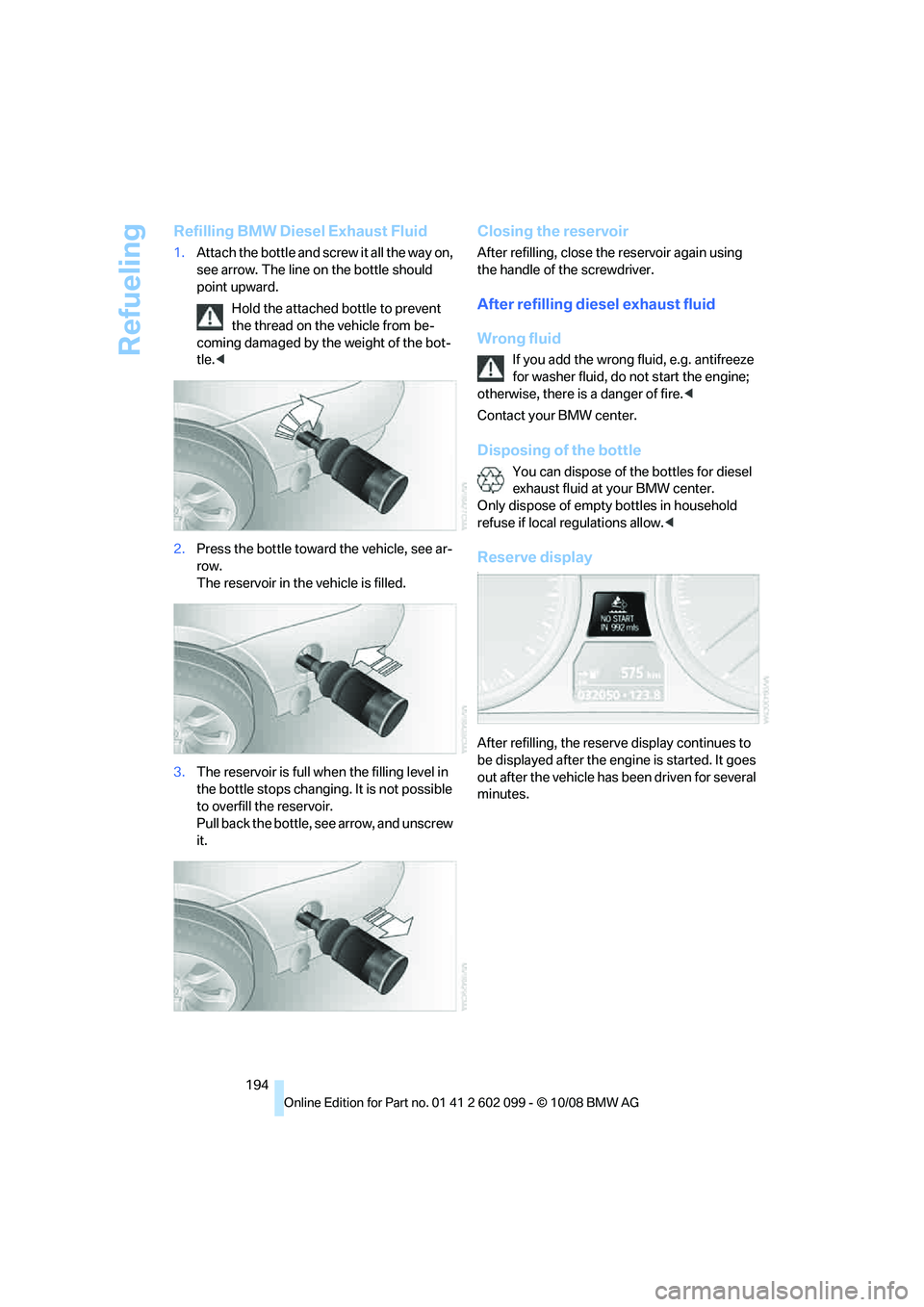
Refueling
194
Refilling BMW Diesel Exhaust Fluid
1.Attach the bottle and sc rew it all the way on,
see arrow. The line on the bottle should
point upward.
Hold the attached bottle to prevent
the thread on the vehicle from be-
coming damaged by the weight of the bot-
tle. <
2. Press the bottle toward the vehicle, see ar-
row.
The reservoir in the vehicle is filled.
3. The reservoir is full wh en the filling level in
the bottle stops changing. It is not possible
to overfill the reservoir.
Pull back the bottle, see arrow, and unscrew
it.
Closing the reservoir
After refilling, close the reservoir again using
the handle of the screwdriver.
After refilling diesel exhaust fluid
Wrong fluid
If you add the wrong fluid, e.g. antifreeze
for washer fluid, do not start the engine;
otherwise, there is a danger of fire. <
Contact your BMW center.
Disposing of the bottle
You can dispose of the bottles for diesel
exhaust fluid at your BMW center.
Only dispose of empty bottles in household
refuse if local regulations allow. <
Reserve display-
After refilling, the reserv e display continues to
be displayed after the engi ne is started. It goes
out after the vehicle has been driven for several
minutes.
ba8_E9091_cic.book Seite 194 Mittwoch, 29. Oktober 2008 2:59 14
Page 197 of 268
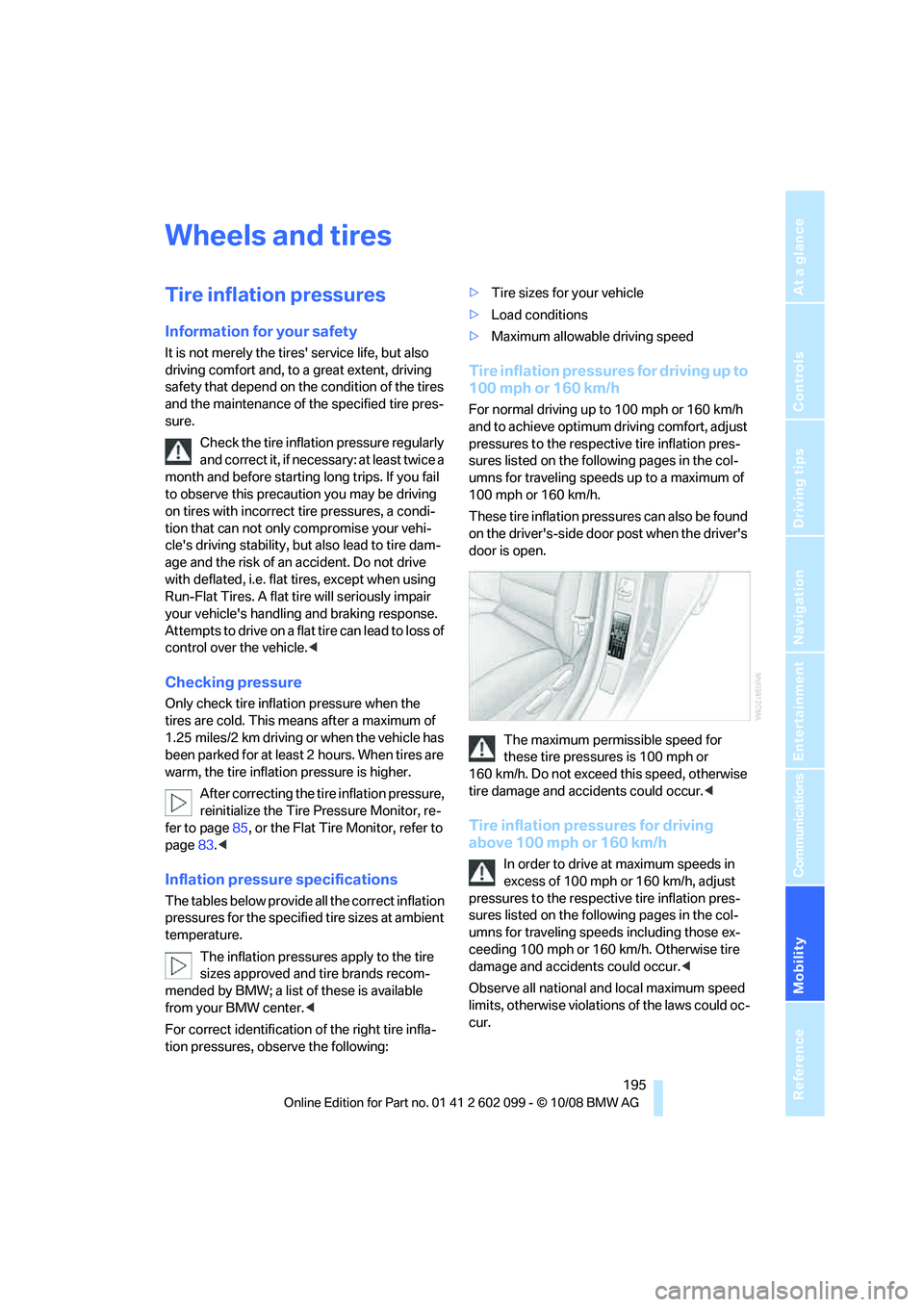
Mobility
195Reference
At a glance
Controls
Driving tips
Communications
Navigation
Entertainment
Wheels and tires
Tire inflation pressures
Information for your safety
It is not merely the tires' service life, but also
driving comfort and, to a great extent, driving
safety that depend on th e condition of the tires
and the maintenance of the specified tire pres-
sure.
Check the tire inflation pressure regularly
and correct it, if nece ssary: at least twice a
month and before starting long trips. If you fail
to observe this precauti on you may be driving
on tires with incorrect tire pressures, a condi-
tion that can not only compromise your vehi-
cle's driving stability, but also lead to tire dam-
age and the risk of an accident. Do not drive
with deflated, i.e. flat tires, except when using
Run-Flat Tires. A flat tire will seriously impair
your vehicle's handling and braking response.
Attempts to drive on a flat tire can lead to loss of
control over the vehicle. <
Checking pressure
Only check tire inflation pressure when the
tires are cold. This means after a maximum of
1.25 miles/2 km driving or when the vehicle has
been parked for at least 2 hours. When tires are
warm, the tire inflation pressure is higher.
After correcting the tire inflation pressure,
reinitialize the Tire Pressure Monitor, re-
fer to page 85, or the Flat Tire Monitor, refer to
page 83.<
Inflation pressure specifications
The tables below provide all the correct inflation
pressures for the specified tire sizes at ambient
temperature.
The inflation pressures apply to the tire
sizes approved and tire brands recom-
mended by BMW; a list of these is available
from your BMW center. <
For correct identification of the right tire infla-
tion pressures, observe the following: >
Tire sizes for your vehicle
> Load conditions
> Maximum allowable driving speed
Tire inflation pressures for driving up to
100 mph or 160 km/h
For normal driving up to 100 mph or 160 km/h
and to achieve optimum driving comfort, adjust
pressures to the respecti ve tire inflation pres-
sures listed on the follo wing pages in the col-
umns for traveling speeds up to a maximum of
100 mph or 160 km/h.
These tire inflation pres sures can also be found
on the driver's-side door post when the driver's
door is open.
The maximum permissible speed for
these tire pressures is 100 mph or
160 km/h. Do not exceed this speed, otherwise
tire damage and accidents could occur. <
Tire inflation pressures for driving
above 100 mph or 160 km/h
In order to drive at maximum speeds in
excess of 100 mph or 160 km/h, adjust
pressures to the respecti ve tire inflation pres-
sures listed on the follo wing pages in the col-
umns for traveling speeds including those ex-
ceeding 100 mph or 160 km/h. Otherwise tire
damage and accidents could occur. <
Observe all national an d local maximum speed
limits, otherwise violations of the laws could oc-
cur.
ba8_E9091_cic.book Seite 195 Mittwoch, 29. Oktober 2008 2:59 14
Page 198 of 268
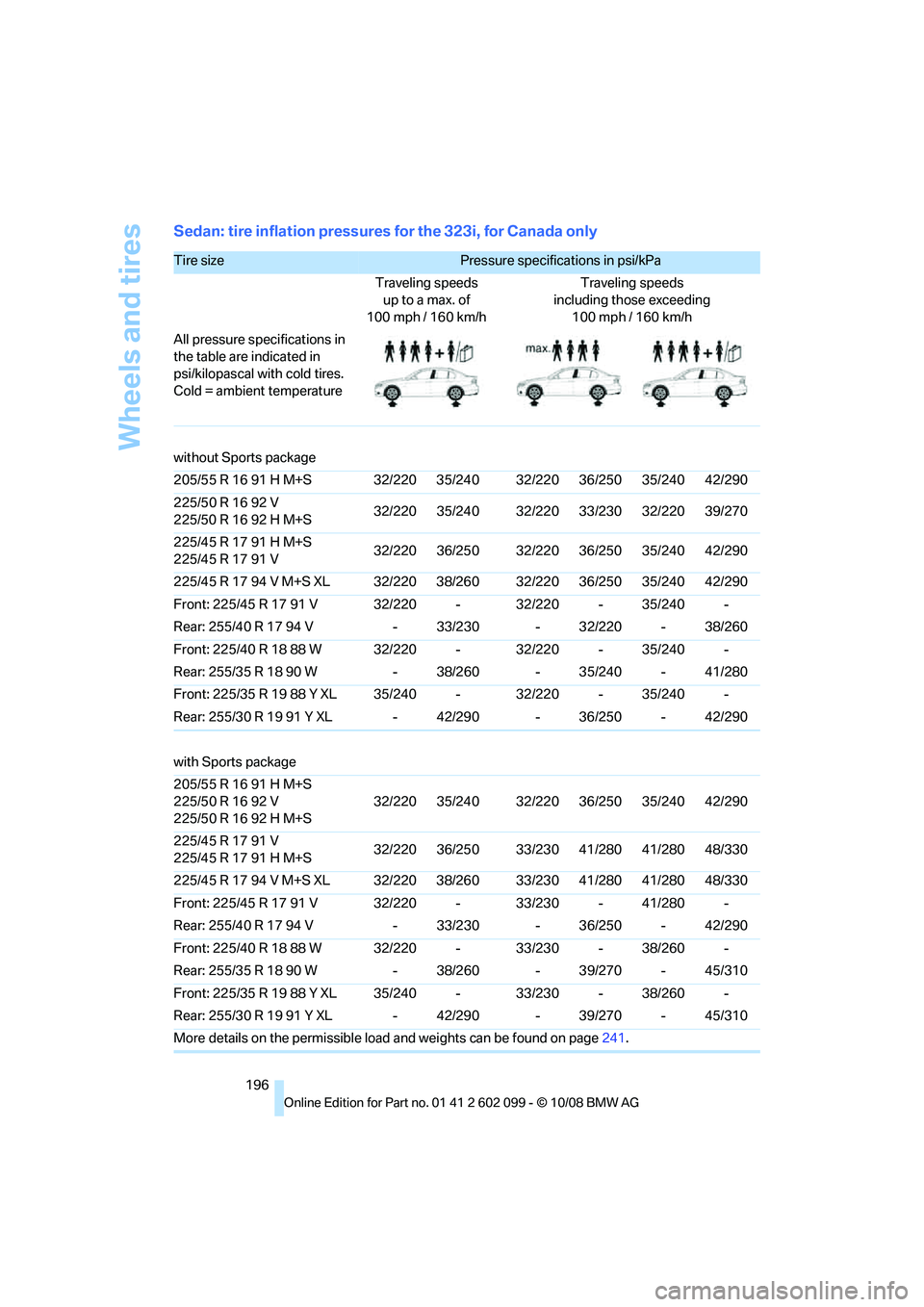
Wheels and tires
196
Sedan: tire inflation pressures for the 323i, for Canada only
Tire size Pressure specifications in psi/kPa
Traveling speeds up to a max. of
100 mph / 160 km/h Traveling speeds
including those exceeding 100 mph / 160 km/h
All pressure specifications in
the table are indicated in
psi/kilopascal with cold tires.
Cold = ambient temperature
without Sports package
205/55 R 16 91 H M+S 32/220 35/240 32/220 36/250 35/240 42/290
225/50 R 16 92 V
225/50 R 16 92 H M+S 32/220 35/240 32/220 33/230 32/220 39/270
225/45 R 17 91 H M+S
225/45 R 17 91 V 32/220 36/250 32/220 36/250 35/240 42/290
225/45 R 17 94 V M+S XL 32/220 38/260 32/220 36/250 35/240 42/290
Front: 225/45 R 17 91 V 32/220 - 32/220 - 35/240 -
Rear: 255/40 R 17 94 V - 33/230 - 32/220 - 38/260
Front: 225/40 R 18 88 W 32/220 - 32/220 - 35/240 -
Rear: 255/35 R 18 90 W - 38/260 - 35/240 - 41/280
Front: 225/35 R 19 88 Y XL 35/240 - 32/220 - 35/240 -
Rear: 255/30 R 19 91 Y XL - 42/290 - 36/250 - 42/290
with Sports package
205/55 R 16 91 H M+S
225/50 R 16 92 V
225/50 R 16 92 H M+S 32/220 35/240 32/220 36/250 35/240 42/290
225/45 R 17 91 V
225/45 R 17 91 H M+S 32/220 36/250 33/230 41/280 41/280 48/330
225/45 R 17 94 V M+S XL 32/220 38/260 33/230 41/280 41/280 48/330
Front: 225/45 R 17 91 V 32/220 - 33/230 - 41/280 -
Rear: 255/40 R 17 94 V - 33/230 - 36/250 - 42/290
Front: 225/40 R 18 88 W 32/220 - 33/230 - 38/260 -
Rear: 255/35 R 18 90 W - 38/260 - 39/270 - 45/310
Front: 225/35 R 19 88 Y XL 35/240 - 33/230 - 38/260 -
Rear: 255/30 R 19 91 Y XL - 42/290 - 39/270 - 45/310
More details on the permissible load and weights can be found on page241.
ba8_E9091_cic.book Seite 196 Mittwoch, 29. Oktober 2008 2:59 14
Page 199 of 268
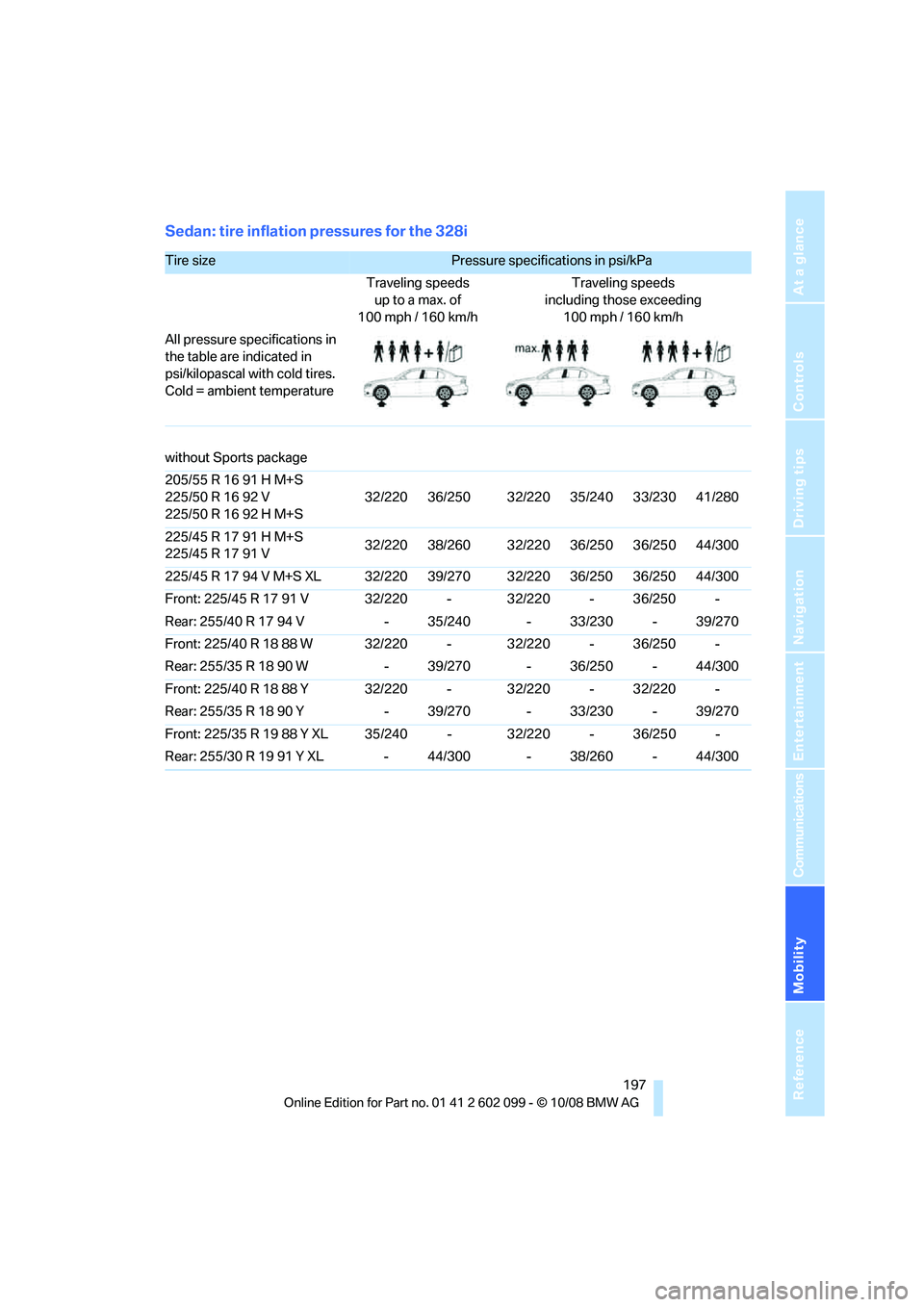
Mobility
197Reference
At a glance
Controls
Driving tips
Communications
Navigation
Entertainment
Sedan: tire inflation pressures for the 328i
Tire size Pressure specifications in psi/kPa
Traveling speeds up to a max. of
100 mph / 160 km/h Traveling speeds
including those exceeding 100 mph / 160 km/h
All pressure specifications in
the table are indicated in
psi/kilopascal with cold tires.
Cold = ambient temperature
without Sports package
205/55 R 16 91 H M+S
225/50 R 16 92 V
225/50 R 16 92 H M+S 32/220 36/250 32/220 35/240 33/230 41/280
225/45 R 17 91 H M+S
225/45 R 17 91 V 32/220 38/260 32/220 36/250 36/250 44/300
225/45 R 17 94 V M+S XL 32/220 39/270 32/220 36/250 36/250 44/300
Front: 225/45 R 17 91 V 32/220 - 32/220 - 36/250 -
Rear: 255/40 R 17 94 V - 35/240 - 33/230 - 39/270
Front: 225/40 R 18 88 W 32/220 - 32/220 - 36/250 -
Rear: 255/35 R 18 90 W - 39/270 - 36/250 - 44/300
Front: 225/40 R 18 88 Y 32/220 - 32/220 - 32/220 -
Rear: 255/35 R 18 90 Y - 39/270 - 33/230 - 39/270
Front: 225/35 R 19 88 Y XL 35/240 - 32/220 - 36/250 -
Rear: 255/30 R 19 91 Y XL - 44/300 - 38/260 - 44/300
ba8_E9091_cic.book Seite 197 Mittwoch, 29. Oktober 2008 2:59 14
Page 200 of 268
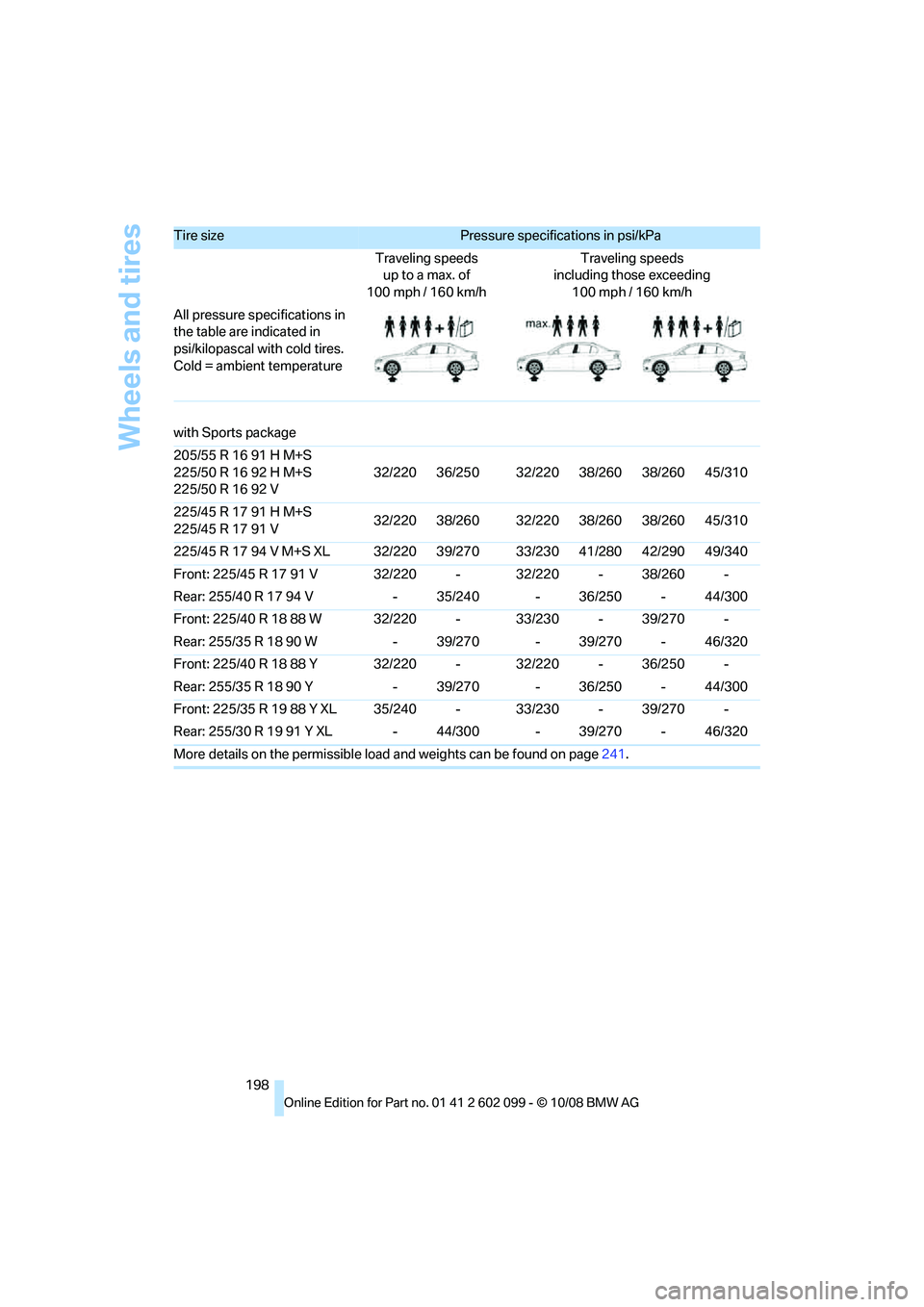
Wheels and tires
198
with Sports package
205/55 R 16 91 H M+S
225/50 R 16 92 H M+S
225/50 R 16 92 V
32/220 36/250 32/220 38/260 38/260 45/310
225/45 R 17 91 H M+S
225/45 R 17 91 V 32/220 38/260 32/220 38/260 38/260 45/310
225/45 R 17 94 V M+S XL 32/220 39/270 33/230 41/280 42/290 49/340
Front: 225/45 R 17 91 V 32/220 - 32/220 - 38/260 -
Rear: 255/40 R 17 94 V - 35/240 - 36/250 - 44/300
Front: 225/40 R 18 88 W 32/220 - 33/230 - 39/270 -
Rear: 255/35 R 18 90 W - 39/270 - 39/270 - 46/320
Front: 225/40 R 18 88 Y 32/220 - 32/220 - 36/250 -
Rear: 255/35 R 18 90 Y - 39/270 - 36/250 - 44/300
Front: 225/35 R 19 88 Y XL 35/240 - 33/230 - 39/270 -
Rear: 255/30 R 19 91 Y XL - 44/300 - 39/270 - 46/320
More details on the permissible load and weights can be found on page241.
Tire size Pressure specifications in psi/kPa
Traveling speeds up to a max. of
100 mph / 160 km/h Traveling speeds
including those exceeding 100 mph / 160 km/h
All pressure specifications in
the table are indicated in
psi/kilopascal with cold tires.
Cold = ambient temperature
ba8_E9091_cic.book Seite 198 Mittwoch, 29. Oktober 2008 2:59 14